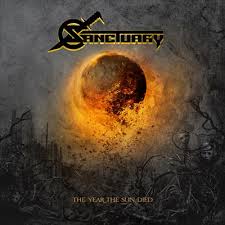
Album Review: Sanctuary - The Year The Sun Died
Twenty-five years is an eternity. It's an entire generation that has come and gone, and that is how long it's been since Sanctuary has released an album. Their two records from the late 80's are underground classics, but the band is best known for what they became; Nevermore. It was that band that was able to break through and become one of the bigger names in metal, and it's that band that would make the bigger splash by returning at this time. Instead, Sanctuary has gone back in time to pick up where they left off, as though the last twenty years had never happened. Nostalgia is a powerful drug, and while there are legions of fans out there who are going to be grateful merely that this album exists, I can't claim to have any memories of Sanctuary to fall back on.
Sanctuary's defining characteristic is, and always was, singer Warrell Dane. His massive baritone voice, and shrieking high notes, are unrivaled by anyone in metal. No one sounds like Dane, no one could even if they wanted to, and his voice is what makes the comparisons between Sanctuary and Nevermore inevitable. With that said, that will be the last time I mention the latter.
“The Year The Sun Died” is both a modern and vintage record at the same time. It is modern in the sense that the production adheres to every standard of modern metal, from the cookie-cutter guitar tone, to the compression that makes it tiring to listen to by the time the end is reached. But it is a vintage record in the sense that, if the production were messier, the songwriting is lifted straight from the “Into The Mirror Black” era.
“Arise And Purify” is all thrashing thunder, with Dane's voice towering over the riffing with a presence few can match. His lyrics are typically dense, which is a welcome relief. Dane is one of metal's more interesting lyricists, and one look at the titles on this album will show that this isn't your standard 'drink, fight, and party' metal record.
This is most definitely a thinking man's metal record, but that is a mixed blessing. While the songs are deeper than most, and there are some interesting twists and turns in the structures, all of that means that the songs take time to digest. This is not a record that you can listen to once and fall in love with it. Multiple listens are required before the songs open up and reveal themselves. On first blush, many of these songs are prone to sounding flat, dull, and tuneless. It's only with repeated visits that you begin to hear the nuances that are built into the songs, and the hooks start to make their impressions. Such a trait might mean the album will age well, but it also means fewer people are going to stick with it long enough to appreciate it.
As the title suggests, “The Year The Sun Died” is a dark record, one that doesn't offer much in the way of optimism. The sounds and tones are somber and depressing, and even the more energetic moments of the record remain downbeat. For a band that is in the midst of a resurrection, it's a bit of an odd feeling to be so pervasive throughout the record.
My impression of “The Year The Sun Died” is that it's one of the better metal records I've heard this year, but it's one that I think requires too much work to truly enjoy. These songs have riffs and hooks, but they're too subtle for their own good. A lot has changed in the twenty-five years since Sanctuary last released an album, and one of those things is that there is now so much metal out there that merely being competent isn't good enough. You have to deliver something with teeth, and while “The Year The Sun Died” is good, I don't think it's quite sharp enough to make the right impact.

